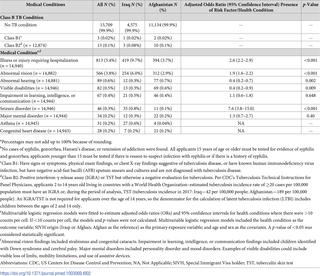PLOS Medicine ( IF 15.8 ) Pub Date : 2020-03-17 , DOI: 10.1371/journal.pmed.1003069 Simone S Wien 1, 2 , Gayathri S Kumar 1 , Oleg O Bilukha 3 , Walid Slim 4 , Heather M Burke 1, 5 , Emily S Jentes 1

|
Background
The United States has admitted over 80,000 Special Immigrant Visa holders (SIVH), which include children. Despite the increase in the proportion of SIVH admissions to the US over recent years, little is known about health conditions in SIV children. We report the frequency of selected diseases identified overseas and assess differences in selected conditions between SIV children from Iraq and Afghanistan.
Methods and findings
We analyzed 15,729 overseas medical exam data in Centers for Disease Control and Prevention’s Electronic Disease Notification system (EDN) for children less than 18 years of age from Iraq (29.1%) and Afghanistan (70.9%) who were admitted to the US from April 2009 through December 2017 in a cross-sectional analysis. Variables included age, sex, native language, measured height and weight, and results of the overseas medical examination. From our analysis, less than 1% of SIV children (Iraqi: 0.1%; Afghan: 0.12%) were reported to have abnormal tuberculosis test findings, less than 1% (Iraqi: 0.3%; Afghan: 0.7%) had hearing abnormalities, and about 4% (Iraqi: 6.0% Afghan: 2.9%) had vision abnormalities, with a greater prevalence of vision abnormalities noted in Iraqis (OR: 1.9, 95% CI 1.6–2.2, p <0.001). Seizure disorders were noted in 46 (0.3%) children, with Iraqis more likely to have a seizure disorder (OR: 7.6, 95% CI 3.8–15.0, p < 0.001). On average, children from Afghanistan had a lower mean height-for-age z-score (Iraqi: −0.28; Afghan: −0.68). Only the data quality assessment for height for age for children ≥5 years fell within WHO recommendations. Limitations included the inability to obtain all SIVH records and self-reported medical history of noncommunicable diseases.
Conclusion
In this investigation, we found that less than 1% of SIV children were reported to have abnormal tuberculosis test findings and 4% of SIV children had reported vision abnormalities. Domestic providers caring for SIVH should follow the US Centers for Disease Control and Prevention (CDC) Guidelines for the US Domestic Medical Examination for Newly Arriving Refugees, including an evaluation for malnutrition. Measurement techniques and anthropometric equipment used in panel site clinics should be assessed, and additional training in measurement techniques should be considered. Future analyses could further explore the health of SIV children after resettlement in the US.
中文翻译:

从伊拉克和阿富汗到达美国的小儿特殊移民签证持有人的健康状况,2009-2017年:横断面分析。
背景
美国已接纳超过80,000名特殊移民签证持有人(SIVH),其中包括儿童。尽管近年来SIVH进入美国的比例有所增加,但对SIV儿童的健康状况知之甚少。我们报告了在海外发现的某些疾病的发生频率,并评估了伊拉克和阿富汗的SIV儿童在某些疾病中的差异。
方法和发现
我们从疾病控制与预防中心的电子疾病通报系统(EDN)中分析了15729项海外医学检查数据,这些数据来自2009年4月从美国(伊拉克)占29.1%和阿富汗(70.9%)入学的18岁以下儿童。到2017年12月的横截面分析。变量包括年龄,性别,母语,测得的身高和体重以及海外体检结果。根据我们的分析,据报告,只有不到1%的SIV儿童(伊拉克:0.1%;阿富汗人:0.12%)有结核病检查结果异常;少于1%(伊拉克:0.3%;阿富汗人:0.7%)有听力异常,约4%(伊拉克:6.0%阿富汗:2.9%)患有视力异常,伊拉克人中视力异常的患病率更高(OR:1.9,95%CI 1.6–2.2,p<0.001)。在46名(0.3%)儿童中发现了癫痫病,伊拉克人更容易患癫痫病(OR:7.6,95%CI 3.8-15.0,p <0.001)。平均而言,来自阿富汗的儿童的平均年龄高度z得分较低(伊拉克:-0.28;阿富汗:-0.68)。世卫组织的建议中,只有年龄≥5岁的儿童的身高数据质量评估才符合要求。局限性包括无法获取所有SIVH记录以及自我报告的非传染性疾病病史。
结论
在这项调查中,我们发现不到1%的SIV儿童报告有异常的结核病检查结果,而4%的SIV儿童报告了视力异常。照顾SIVH的国内医疗服务提供者应遵循美国疾病控制与预防中心(CDC)的《美国新来难民家庭医疗检查指南》,包括营养不良评估。应评估专门小组诊所使用的测量技术和人体测量设备,并应考虑对测量技术进行额外培训。未来的分析可能会进一步探讨美国移民后SIV儿童的健康状况。



























 京公网安备 11010802027423号
京公网安备 11010802027423号